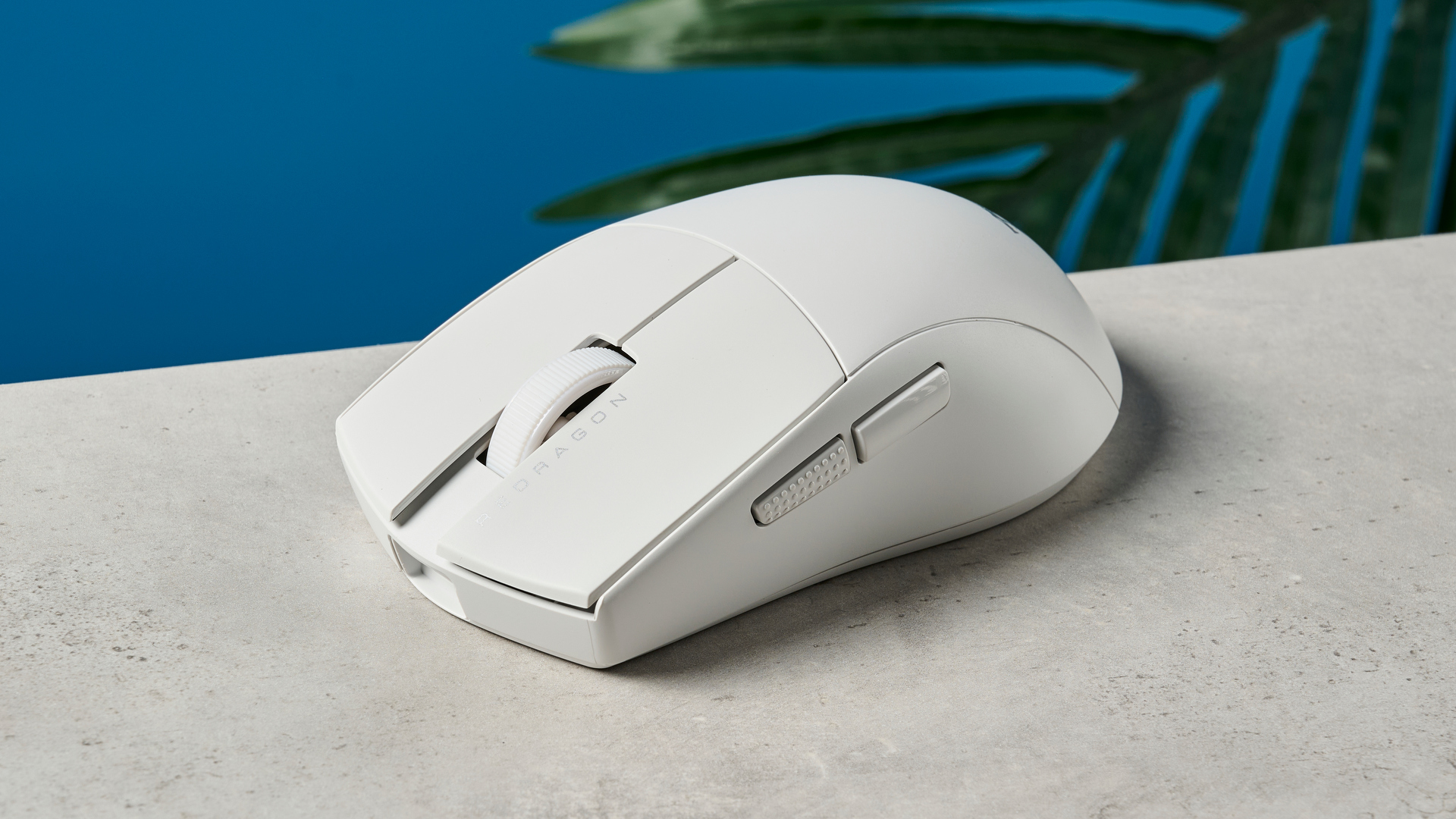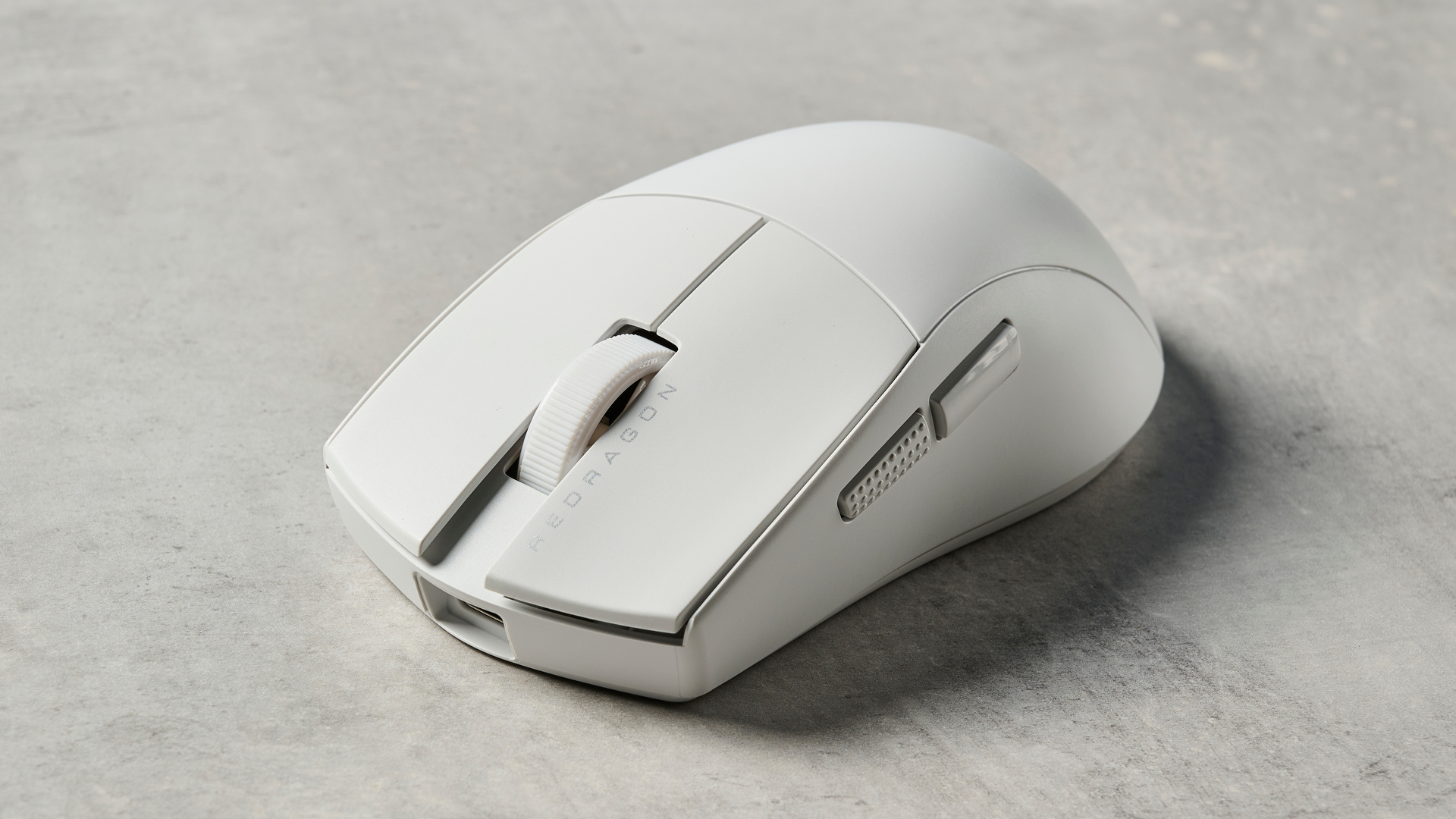
I was seriously surprised by the Redragon M916 Pro ($44). One of the lightest mice I’ve ever used, the M916 shows that budget mice needn’t compromise on gaming potential.
The M916 packs a 4,000 Hz polling rate, which is a lot of performance for this price. On top of this comes a great array of features, offering the same, if not more capability than mice that cost $100 more. The M916’s super low weight (1.7 ounces) does not sacrifice durability, and its solid construction makes me feel secure using the mouse for travel.
However, there’s a catch. While it’s put together well, the great value of the mouse is a result of using inexpensive materials: the simple ABS case and low quality Teflon feet detract from any notion of premium feel. Ergonomically, the mouse is also lacking, which is disappointing given other similarly cheap mice like the Keychron M7 ($TK) prove that comfort needn’t be exchanged for price or performance. Combined, these factors leave the M916 feeling a little frustrating to use in comparison to other budget wireless mice like the Corsair Harpoon ($50).
That said, there’s no getting around the seriously impressive gaming performance, so if you’re on a budget, this could easily be one of the best gaming mice you can get your hands on, and all for less than $50.
Find out more in our full Redragon M916 Pro review.
Redragon M916 Pro review: Cheat Sheet
- What is it? An ultra-lightweight budget wireless gaming mouse
- Who is it for? Anyone looking for the performance of a $100+ gaming mouse at a fraction of the cost
- What does it cost? $44 on Amazon, but as low as $35 from Redragon. The 1,000 Hz version can be picked up for only $34, but we’ve seen it go as low as $27!
- What do we like? An extremely light build that doesn’t compromise on performance
- What don’t we like? The construction is a bit on the cheap side, and the 4K polling rate might be redundant for casual gamers
Redragon M916 Pro review: Specs
Redragon M916 Pro review: The ups
The M916 is a highly capable mouse for an incredibly attractive price. The wonderfully light build combined with a polling rate of 4,000 Hz and a maximum DPI of 26,000 makes this a dream to use for competitive gaming. The simple, clean design and solid construction are cherries on top of a fantastic budget mouse.
Features

The M916 is packed with an array of features I would expect to see on a more expensive gaming mouse. This has everything for someone who wants to get the most out of their gaming. There’s angle snapping, for a start: a great feature that removes small inaccuracies from your mouse movements. This worked as well as the angle snapping found on the Turtle Beach Kone XP Air ($129), and I actually preferred how it felt on the M916 compared to the SteelSeries Aerox 5 ($139). This made the most significant impact in FPS games, where it helped to keep my crosshair placement level.

Other features include motion sync, which essentially increases the accuracy of the sensor but at the expense of a 1ms delay. I did not use this due to the delay in response times, making the option subpar for competitive games, but those who value accuracy over responsiveness would definitely benefit from this. Ripple control is similar in that it adds some latency to the mouse reading, but smooths out mouse movements at high DPI. Again, not useful for everyone, but great to have as an option. Neither of these features are available on the Aerox or Kone XP Air, so it is interesting to see less common functionality available on M916.
Companion Software

The powerful features mentioned above are all accessible via the driver software, although this is available for Windows only. This works brilliantly, and displays all of the performance-related features on one page. It allows for full macro customization, useful for the two side buttons, as well as full button remapping (besides left click.) Admittedly, it is a relatively simple app, but I don’t have any problems with that: this makes it easy to use, and sometimes simpler is just better.
Performance
The M916 is great for gaming. I keep the mouse at between 500-1000 DPI, although it’s capable of up to 26,000 DPI — absolutely crushing the low caps of budget mice like the SteelSeries Rival 3 ($30) at just 8,500, while matching higher-end wireless mice like the Alienware Pro ($149) at 26,000. The sensor was perfect for FPS games, with both response times and accuracy feeling spot on. There is very little to separate the M916 from a mouse worth nearly $100 more — the Turtle Beach Kone XP Air ($129) I recently reviewed is equivalent in terms of raw performance.

That said, it’s hard to recommend the 4,000 Hz model for anyone except the most competitive-minded gamers. To make the most of this setting, you will need a very high refresh rate monitor, and even then the difference will not be very noticeable. If you’re after an even more budget mouse, consider the 1,000 Hz version of the mouse instead for just $35 from Redragon.
Construction

Despite the low price, the construction of the M916 is great (even if the materials themselves are not — more on that later). It’s put together very sturdily. All buttons and inputs offer great tactile feedback and responsiveness. I was particularly impressed by the thumb buttons, with the front one having a very simple studded plastic texture which helped avoid accidental presses. These felt as responsive as the primary mouse buttons, which gave me the confidence to incorporate them more into my keybindings for games and casual use. I was able to pull off rapid clicks with the short actuation distance of the left and right mouse buttons, great for high-APM strategy games or MOBAs.

Mouse clicks sound defined, but not too loud, which I love — I usually have problems with my microphone picking up loud mouse clicks, and find the noise a frustrating distraction in games. This also makes the M916 as good in the office as it is for competitive gaming, so it’s a versatile little thing.
Weight
The knockout punch of the M916 is the extremely low weight. At only 1.7 ounces, or 49 grams, the M916 outclasses both the Razer Viper V2 ($149) and Logitech G Pro X Superlight ($149) by 0.4 ounces. At this weight, the M916 has a practically negligible mass when moving, allowing lightning-fast reaction speeds much more easily than with a heavier pointer. It also makes the M916 highly portable — the USB-C cable weighs more than the mouse itself, so it’s very easy to take on the go and stops you needing to use a laptop trackpad.
Redragon M916 Pro review: The downs
There are a few problems that may prevent the M916 from being a flat out recommendation. Some aspects of the mouse, notably the appearance and general feel, are the obvious sacrifices made to keep costs low. Its lack of ergonomics will affect comfort and long term useability, too.
Cheap Materials

The main issue with the M916 are the cheap materials used in the build, which, in fairness, aren’t unexpected at this price. As I mentioned earlier, while the actual construction is sturdy and held up to being carried loose in my bag, the plastic feels very cheap and thin, while the feet provide too much friction when moving the mouse and undermine its light frame — unusual for a mouse with PTFE feet, which usually help reduce friction. What’s more, while the feet can be easily replaced, after only a week's worth of usage I noticed some visible wear on them.
Appearance
Of course, beauty is in the eye of the beholder, but part of me wishes there was something at least a little more interesting going on with the M916’s visual design. Besides ‘Redragon’ printed on the left mouse button, and the eponymous scaled creature on the shell, this is an incredibly simple design.

Besides a single (customizable) RGB light underneath the mouse to indicate DPI profile, there are no thrills to be had with lighting on the M916. While RGBs often come at a premium, some cheaper mice like the SteelSeries Rival 3 offer some level of lighting, which would have been nice to see on the M916. This is a mouse on the complete opposite end of the spectrum from the lighting seen on mice like the Turtle Beach Kone XP Air, although I appreciate that the M916 doesn't look out of place in the office as well as at a gaming desktop setup.
Ergonomics

Unfortunately, I also found that the measurements of the mouse were a little off of what I would prefer from a gaming mouse. While mimicking the best aspects of wireless mice like the Razer Deathadder V3, the M916 features a much harsher incline towards the middle of the mouse and a shorter length overall, which makes the mouse slightly uncomfortable for a palm grip. You should be able to use the M916 for both a claw and palm grip, but the dimensions here did not quite fit my hand, especially as I prefer longer mice. Those with larger hands may struggle.
Redragon M916 Pro review: Verdict
It is downright impressive that Redragon is able to pull off a high performance gaming mouse at such a low weight, on the shelves for less than $50. While there are cheaper options, none offer the level of customization and raw performance that the M916 promises, and for this alone it is an easy recommendation for the price point.
The minor issues I had regarding the cheap materials could be resolved by stretching your budget, with the Razer Deathadder V2 ($59) providing a high quality build at a low price with a better ergonomic feel, although at the cost of some features and the low weight of the M916. If the lack of ergonomic support is a problem, or if you want to lean into the aspects that make the M916 good for productivity, you might be interested in the sleek design of the Keychron M7 ($49) for an extra $5.
If you can look past some of the cut corners, though, the Redragon M916 is one of the best budget mice I have seen for less than $50. If you’re after an ultra lightweight mouse, with fantastic gaming performance to boot, you can’t go wrong with the M916.







